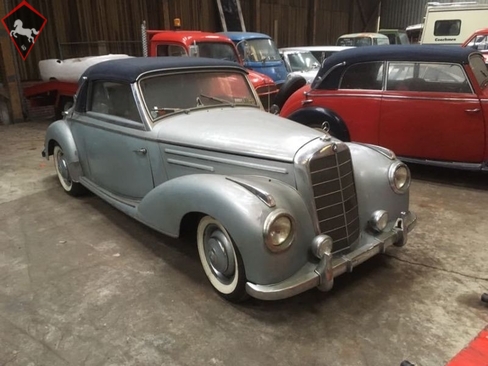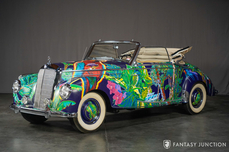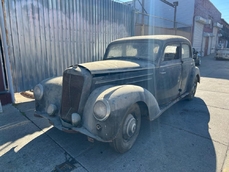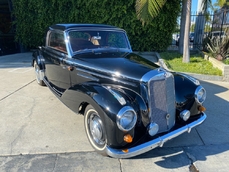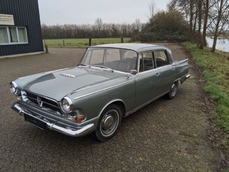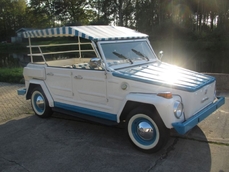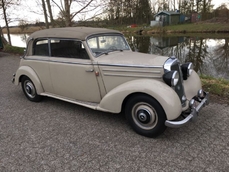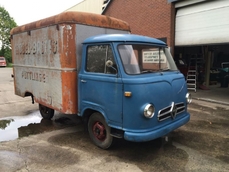Mercedes-Benz 220 W187 Cabrio A 1952
General description :
Informationen auf Deutsch
Weitere Informationen
Türenzahl: 2
Zylinderzahl: 6Informatie in het Nederlands
Opmerkingen
Dit is een mooie ongerestaureerde auto die uit een grote Mercedes verzameling afkomstig is vanuit Californië. Deze auto heeft maar 1 eigenaar gehad en ziet er heel mooi uit met zijn grijze lak en blauwe dak.
De Mercedes-Benz W187 is een full-size luxeauto geproduceerd door Mercedes-Benz van 1951 tot 1955. Geïntroduceerd op de Frankfurt Motor Show in april 1951 werd hij aangedreven door een inline zescilinder M180 motor en was beschikbaar als een salon , coupé en cabriolet, allemaal aangeduid met de 220 modelnaam. Ondanks de reputatie van vóór de Tweede Wereldoorlog als een fabrikant van luxe auto's, produceerde Mercedes-Benz in de naoorlogse jaren alleen personenauto's met viercilindermotoren. De W187 Mercedes-Benz 220 en het vlaggenschip W186 Mercedes-Benz 300 Adenauer, samen geïntroduceerd in 1951, waren de eerste Mercedes met opnieuw zescilindermotoren.
Dies ist ein schönes unrestauriertes Auto, das aus einer großen Mercedes-Sammlung aus Kalifornien stammt. Dieses Auto hat nur einen Besitzer und sieht sehr gut aus mit seiner grauen Farbe und dem blauen Dach.
Der Mercedes-Benz W187 ist ein Full-Size-Luxus-Auto von Mercedes-Benz von 1951 bis 1955. Eingeführt auf der Frankfurt Motor Show im April 1951 wurde es von einem Reihensechszylinder-M180-Motor angetrieben und als Limousine erhältlich , Coupé und Cabriolet, alle mit dem Modellnamen 220 bezeichnet. Trotz seines Rufes als Hersteller von Luxusautos vor dem Zweiten Weltkrieg produzierte Mercedes-Benz in den unmittelbaren Nachkriegsjahren nur Vierzylinder-Personenwagen. Der W187 Mercedes-Benz 220 und das Flaggschiff W186 Mercedes-Benz 300 Adenauer stellten 1951 gemeinsam den ersten Mercedes vor, der erneut mit Sechszylinder-Motoren ausgestattet war.
---
This is a beautiful unrestored car that comes from a large Mercedes collection from California. This car has only one owner and looks very nice with its gray paint and blue roof.
The Mercedes-Benz W187 is a full-size luxury car produced by Mercedes-Benz from 1951 to 1955. Introduced_at the Frankfurt Motor Show in April 1951 it was powered by a single overhead camshaft inline six-cylinder M180 engine and available as a saloon, coupé, and cabriolet, all designated with the 220 model name. Despite its pre-World War II reputation as a manufacturer of luxury cars, in the immediate post-war years Mercedes-Benz produced only four-cylinder-engined passenger cars. The W187 Mercedes-Benz 220 and flagship W186 Mercedes-Benz 300 Adenauer introduced together in 1951 were the first Mercedes to once again feature six-cylinder engines.
Meer informatie
Aantal deuren: 2
Aantal cilinders: 6
BTW/marge: BTW niet verrekenbaar (margeregeling)
Bedrijfsinformatie
Zater...
1952 Mercedes-Benz 220 W187 Cabrio A is listed for sale on ClassicDigest in Ettensestraat 19NL-7061 AA Terborg by POTOMAC CLASSICS B.V. for €110000.
Car Facts
Car type : Car Make : Mercedes-Benz Model : 220 W187 Model Version : Cabrio A Engine size : 2.2 Model Year : 1952 Sub type : Convertible Location : Ettensestraat 19NL-7061 AA Terborg Vehicle Registration : Undefined
110000 €
People who viewed this Mercedes-Benz 220 W187 also viewed similar Mercedes-Benz listed at ClassicDigest
Other cars listed for sale by this dealer
About Mercedes-Benz
In the annals of automotive history, the journey of Mercedes-Benz is a tale that unfolds with the ingenuity of its founding pioneers. In the year 1886, Karl Benz crafted the Benz Patent Motorwagen, a creation that would go down in history as the world's inaugural automobile. Unbeknownst to him, this moment marked the genesis of what would evolve into the most illustrious premium car manufacturer globally. The financial underpinning of this pioneering venture, interestingly, was provided by Karl Benz's wife, Bertha Benz, demonstrating a remarkable partnership that would set the tone for Mercedes-Benz's legacy.A parallel narrative emerged not far away, as Daimler-Motoren-Gesellschaft, founded by Gottlieb Daimler and Wilhelm Maybach, entered the scene. In 1901, they unveiled their automobile under the now-famous moniker "Mercedes," meaning "godsend" in Spanish. This name was bestowed upon the car at the behest of Emil Jellinek's daughter, the distributor for Daimler-Motoren-Gesellschaft. The wheels of innovation were set in motion.
Fast forward to 1926, a pivotal year that witnessed the merger of Daimler with Benz & Cie., culminating in the birth of Daimler-Benz. The amalgamation saw the adoption of "Mercedes-Benz" as the distinguished trademark for their automobiles, fusing the legacies of two visionary entities into one.
Contrary to perceptions of conservatism, the trajectory of Daimler-Benz unfolds as a chronicle of industry firsts. From the introduction of the honeycomb radiator to the float carburetor, and the pioneering implementation of four-wheel brakes in 1924, Daimler-Benz consistently pushed the boundaries of automotive innovation. The diesel-powered Mercedes-Benz 260 D in 1936 marked the inception of diesel engines in passenger cars. The iconic Mercedes-Benz 300SL Gullwing made history as the first car with direct fuel injection, albeit the Gutbrod's tiny 2-stroke engine can claim precedence.
Safety innovations became a hallmark, with Béla Barényi's patented safety cell design in the "Ponton"-models in 1951, featuring front and rear crumple zones. The W116 450SEL 6.9 saw the introduction of the Anti-Lock Brake system (ABS), another pioneering safety feature. From the first production airbags and beyond, the legacy of "firsts" continued to be etched into the fabric of Daimler-Benz.
Over its centennial journey, Mercedes-Benz has not merely produced cars but has sculpted automotive icons. The SSKL, 710 SSK Trossi Roadster, 770K Grosser, 540K Spezial Roadster, 300SL Gullwing, w100 600 Pullman, w111 280SE 3.5 Flachkühler, w113 230SL Pagoda, w109 300 SEL 6.3, and w201 2.3-16 Cosworth stand testament to the brand's commitment to engineering excellence.
The roaring Silver Arrows, or "Silberpfeile," including the W 25, W 125, W154, W165, and W196, created a legacy of dominance on the racetrack. These machines were not merely cars; they were expressions of precision, speed, and an indomitable spirit that left their competitors in the dust.
As Mercedes-Benz marches into the future, it does so not just as an automaker but as a custodian of a legacy, a torchbearer of innovation, and a beacon of automotive excellence. The road ahead is sure to witness the continued fusion of cutting-edge technology, timeless design, and an unwavering commitment to setting new standards in the world of automobiles.
One luminary figure who left an indelible mark was Béla Barényi, often heralded as the "father of passive safety" for his pioneering work in safety engineering. His patented safety cell design, featuring front and rear crumple zones, became a hallmark of Mercedes-Benz's commitment to occupant safety, setting new standards that reverberated throughout the automotive world.
Moving through the chronicles, the collaborative genius of Wilhelm Maybach, alongside Gottlieb Daimler, laid the foundation for Daimler-Motoren-Gesellschaft. Their innovations not only birthed the first Mercedes but established a culture of relentless pursuit of technological excellence that remains integral to Mercedes-Benz's DNA.
In the post-merger era of 1926, Ferdinand Porsche emerged as a prominent figure within Mercedes-Benz. His work on the Mercedes-Benz S-Type, a supercharged race car, garnered acclaim and set the stage for a legacy that extended far beyond the marque. Porsche's impact would later extend to his eponymous company, but his influence at Mercedes-Benz during those formative years was pivotal.
As the 20th century progressed, the legendary Rudolf Uhlenhaut emerged as a key figure. Uhlenhaut, an accomplished engineer and the driving force behind the iconic Silver Arrows, played a crucial role in Mercedes-Benz's dominance in motorsports. His engineering prowess and attention to detail were instrumental in creating some of the most formidable racing cars of the era.
In the latter half of the century, figures like Bruno Sacco, the head of design at Mercedes-Benz from 1975 to 1999, left an indelible imprint on the brand's aesthetic identity. Sacco's design philosophy, characterized by clean lines and timeless elegance, shaped iconic models like the W126 S-Class and the W201 190E, solidifying Mercedes-Benz's reputation for luxury and sophistication.
The narrative would be incomplete without acknowledging the contributions of engineers like Hans Scherenberg, whose leadership in the 1970s ushered in a new era of technological innovation at Mercedes-Benz. Scherenberg's tenure saw the development of groundbreaking technologies, including the Anti-Lock Brake system (ABS) and the introduction of airbags in production cars.
